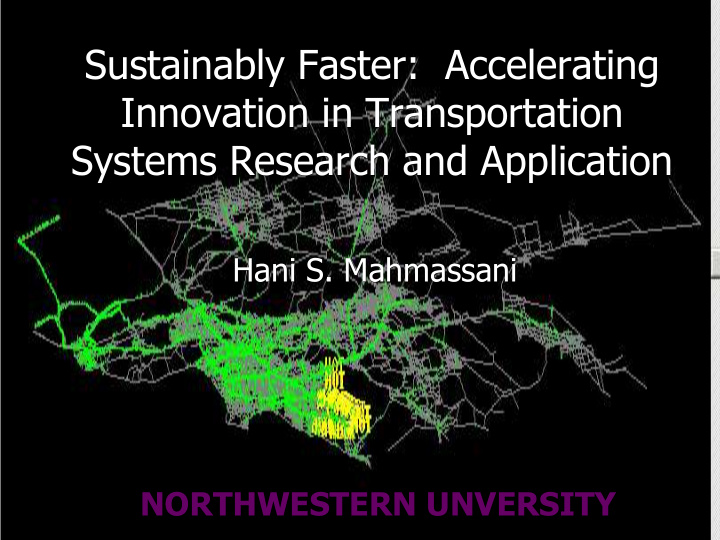



Sustainably Faster: Accelerating Sustainably Faster: Accelerating Innovation in Transportation Innovation in Transportation Systems Research and Application Systems Research and Application Hani S. Mahmassani Hani S. Mahmassani NORTHWESTERN UNVERSITY
??
TRANSPORTATION: PHYSICAL MOBILITY OVER SPACE • Limited growth in capacity, and in output (compared to information –voice and data--traffic) • Social expectations and public policy: diminished expectations of curtailed access, limited over time and space • Subject to considerable inefficiencies, high congestion, arbitrary rules for allocation and use of capacity
TWO STAGES OF ITS DEPLOYMENT Like any application of computers and communications to complex systems, the process is moving through two major stages: • The first stage mainly applies technology to specific tasks, but without changing their character or basic sequence. • In the second stage, entirely new approaches to solving problems and conducting business begin to appear.
Technological Drivers Communications Satellite POS Information Internet Connection Operations Control Center Integrated Mobile Communications Source: Qualcomm.com Terminal
Technological Drivers Information & Communication Technologies (ICT) Information & Communication Technologies (ICT) ITS for Commercial Vehicle Operations (CVO) Vehicle Operations (CVO) ITS for Commercial 2-way Communication Systems Automatic Vehicle Localization (AVL); GPS and Supply Chain Management (SCM) and Supply Chain Management (SCM) EDI; ERP; MRP; RFID => Large amounts of real-time real-time information information on state of system at lower cost
Development trend # 1: Handset Capabilities, Wireless Internet m-commerce e-logistics m-logistics
Development trend # 2: Inexpensive wireless sensor networks Coming to markets near you in next few months… Relative low cost and high performance of such systems would enable deployment at larger scale than envisioned originally. In the limit, nano-scale sensors with massively parallel deployment.
Inexpensive Mobile units + wireless sensors wireless internet: Provides particle Provides view from (user-centric) perspective of views of system infrastructure or fixed assets REAL-TIME INFORMATION
Explosion of real-time information on system state Calls for methods geared for shorter term engineering and business applications Calls for methodologies for real-time decision making under real-time information REAL-TIME DECISION-MAKING METHODOLOGIES , e.g. DYNASMART-X for traffic estimation and prediction. Calls for methods to extract knowledge from undifferentiated data KNOWLEDGE EXTRACTION , e.g. through data mining
Development trend # 3: Network Simulation-Assignment Modeling for Advanced Traffic System Management – Morning peak period (4:00 AM – REAL TIME DYNAMIC TRAFFIC ASSIGNMENT SYSTEM 10:00 AM) – 30-second observation intervals • Irvine network overview: on 19 freeway links – 326 nodes and 626 links. – 5-minute observation interval on – 70 actuated-controlled urban 28 arterial links intersections. – 61 traffic demand zones Estimation Prediction Clock
Development trend # 4: Dynamic Decision Support Tools for Vehicle Routing, Fleet Management and Collaborative Logistics Subject to considerable academic development in the area of algorithm development and testing Rapidly coming to market, in conjunction with asset tracking and management technologies Prospect for tie-ins with predictive traffic management tools, e.g. DYNASMART-X
EIGHT BIG THEMES FOR RESEARCH • EXPLOSION OF REAL-TIME INFORMATION and REAL-TIME DECISION METHODOLOGIES for OPERATIONS: DYNAMIC NETWORK MANAGEMENT (incl. PRICING), INTERMODAL SYSTEMS, COLLABORATIVE LOGISTICS • WIRELESS INTERNET, PERSONAL MOBILE DEVICES, RF TAGS, E_SEALS: – TELEMOBILITY and TELELOGISTICS (CHANGES IN DEMAND), AND – PEOPLE/VEHICLES/SHIPMENTS AS PROBES (SOURCE OF REAL- TIME DATA FOR OPERATION, SURVEY DATA FOR PLANNING) • AUCTIONS and REAL-TIME INTERACTIVE MARKET-BASED MECHANISMS (INCL. PRICING) FOR PROCUREMENT AND CAPACITY ALLOCATION • PEER-TO-PEER, AD-HOC NETWORKING AS SYSTEM MANAGEMENT APPROACHES: IMPLICATIONS FOR SYSTEM RESILIENCY • UNDERSTANDING SYSTEM VULNERABILITY AND RESILIENCY; IMPLICATIONS OF OPERATIONAL CONSIDERATIONS FOR PLANNING AND DESIGN
EIGHT BIG THEMES FOR RESEARCH (ctd.) • USER BEHAVIOR AND RESPONSE: KEY BUILDING BLOCK FOR USE OF INFORMATION AS TOOL FOR POLICY AND CONTROL; BEHAVIOR CHANGE TOWARDS SUSTAINABLE PATTERNS • NEW BUSINESS MODELS FOR INFRASTRUCTURE DEVELOPMENT, OWNERSHIP AND OPERATION; FOR SYSTEM AND SERVICE DEVELOPMENT AND MANAGEMENT. • STRATEGIC MOBILITY, ENERGY AND SUSTAINABILITY
LIGHT AT THE END OF THE TUNNEL? BAC Meeting Transportation Center Northwestern University October 3, 2007
Recommend
More recommend